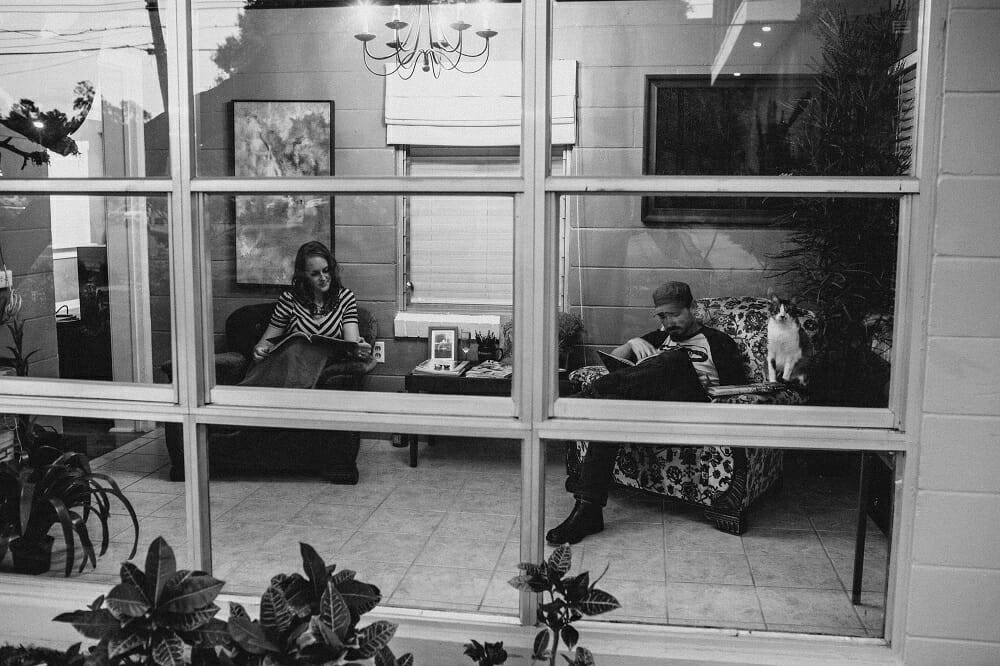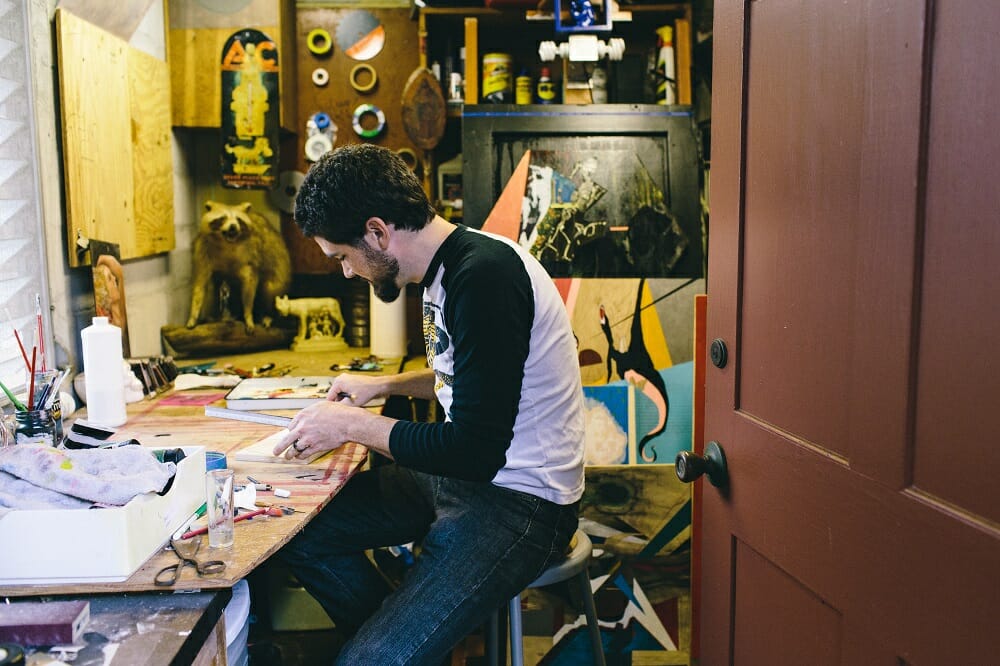Two Lakeland aesthetes prove that opposites do, in fact, attract
Photography by Penny & Finn
On a Friday night, as the breeze wafted through the trees and the mosquitoes feasted on our appendages, my husband and I sat down with Adam and Elyse Justice to talk about the makings of their home just off the shores of Lake Morton. More specifically, we asked about the contrast/interplay between their vocational callings in contemporary art versus decorative arts, and how that plays out into their life together.
He says, “She came with furniture.”
She says, “He came with art.”
Adam explains that when Elyse walked into his life, he was “already in the midst of his curmudgeon,” having worked alone in his office at the William King Museum in Abingdon, Virginia, for nearly a year. Elyse came to fill the position opposite him as curator of decorative arts (he held the same title in the field of modern art). The brainy brunette with her background in art history/decorative arts was the perfect foil to Adam’s more postmodern dialogue. They became fast friends, and as their relationship developed, it turned into a sort of game to see how long they could keep the romance under wraps, in a town of 8,000 people, no less. On work days, they’d meet for clandestine lunches on an old abandoned railroad track (now a park), and by the time their secret finally came out, Adam was already planning his move to the Sunshine State.

The Lakelander: Describe for us the primary similarities/differences between being the curator of a modern art museum [Polk Museum of Art] versus curator of a historic site
[Pinewood Estate at Bok Tower].
Elyse: At Pinewood, my primary concern is translating a home from the past for current and future generations while at the same time protecting it and its contents. I research the objects we have from the families who lived in the house (like antique furniture and deceased people’s diaries) to better understand their lifestyles, and then employ the objects to help visitors better understand the families’ ways of living or appreciate the objects. I feel as if my job is to put these things in context, and I am a very contextually driven person,
whereas Adam’s role is to help people focus on forms themselves, out of that context.
Adam: One of my concerns is not to preserve a space but to constantly change it. The average length of an exhibition is eight weeks. After that, the process repeats, only with a different
design for different artworks. The space always submits to an exhibition’s checklist of works and its concept. But, all museums, whether they’re historic, artistic, or scientific, strive for
that important educational factor, that broad eye-opening, the collective ah-ha moment. It’s as exciting for us as it is to museum visitors — perhaps even more so. Turning people on to history, science, or art through diverse objects and ideas (from the past, present, and future) is a shared objective for us. I suppose, in order to translate that into our personal lives, Elyse and I collect to appreciate and collect to preserve something about ourselves, but also collect to learn.
TL: The process of coming together to make a home can be traumatic for some couples. She doesn’t want his hunting trophies on the wall or his shot-glass collection taking up space in her cupboards. He doesn’t want to live in a world with girlie florals and furniture you can’t put your drink on. But your home retains a dynamic contrast between feminine/masculine ideas, and you seem to have come together without softening much in either direction. How did you go about the process of combining your collections? Was it a knock-down, drag-out fight — the lady with the fancy china versus the rocker with a penchant for, ahem, not-so- alive animals?
Elyse: It’s not really all that dramatic for us. We both feel strongly that the other should be represented and visible in our home, because it’s “ours,” and, although our tastes are different, they do complement each other. We both enjoy the idea of the Renaissance cabinet of curiosities, where amateur scholars were curating collections of natural history specimens, art, and antiquities, all in one place. Now that we’re married and making more of our selections together, we also check in with each other. We each have veto power if we truly feel strongly against something.
Adam: Actually, we never discussed [the process]. Before Elyse moved to Florida, I had over a year to tag every room of our previous apartment. When we packed up and moved here, it was just stirred while it was being unpacked. (I will, however, admit to a box of antlers, crucifixes, and taxidermy in the closet.) To be honest, Elyse and I are so relaxed with each other that we weren’t concerned with it. I like what I like; she likes what she likes; and we both nod in agreement. It’s just another sign that we belong together.

TL: Does your work influence the way you live at home?
Elyse: Our work definitely influences us. When we moved from our apartment to this house, we made a conscious effort to bring our skills of curating from work to the home, so that things would not look haphazard (at least to us). Because I spend a great deal of time thinking about objects and their meanings, I try to surround myself with things that have certain meanings for me or reflect my personality. Of course, I’ve also developed a greater interest in creating outdoor living spaces since [the move].
Adam: Absolutely. When I was young, people would always tell me to do something I love. I never knew you could do something you’re addicted to. Elyse and I are just collectors by
nature. The fact that we are who we are professionally is directly related to that. I love art. That doesn’t mean I want to speak endlessly about it, but I do want to surround myself with it. The fortune I have to call that my profession is just one reason why I’m a damned lucky guy. That and Elyse, of course.
TL: What has changed about your lifestyle in going from an apartment to living in a house? Or has anything changed at all?
Elyse: We definitely have more space, and I think that has allowed us to stretch our legs and relax more. I personally
love having a separate kitchen. We can also put out more of our collections!
Adam: Square footage, and the ability to own a dog and crank our stereo as loud as we want. We have relaxed a bit more. She has gardens to experiment with. I have a yard that takes twenty minutes (which averages to roughly ten Misfits songs, by the way) to mow. It’s nice to feel personally vested in where we live.
TL: Elyse, you have said you were initially reluctant to move but now are very glad you took the leap and moved here. What convinced you, besides your wonderful man? Was it the Spanish moss dripping from the trees? The Old Florida feel of the place? The incredibly high humidity which makes one glisten with dewy vibrance on a summer day? Or maybe it was the giant cockroaches?
Elyse: I feel as if I should preface this by stating that autumn is my favorite season, and I was moving from the mountains of Virginia, where autumn is just beautiful, so that should indicate how strongly Lakeland appealed to me. Lakeland feels really dynamic — you can sense that people here genuinely want to make changes for the better, and they are so welcoming. I can’t get over the changes that have occurred in the two and a half years that I’ve lived here, especially in Dixieland. Because I’m a historic-preservation nerd, I fell in love
with Lakeland’s beautiful historic fabric. For me, what gives Lakeland that “Old Florida” feeling goes beyond the Spanish moss. It lies in the lakes remaining so open to the public rather than being hidden behind private homes; and the variety of styles of historic architecture, including the commercial buildings around Munn Park, the 1920s’ and 1930s’ bungalows and Mediterranean homes throughout town, and the mid-century modern buildings. I’m a big believer in variety in planning, and I love that so many of Lakeland’s historic districts have single-family residences lined up next to apartments, with maybe a church or even a college plunked down in the middle.
TL: Both of you come from other places [Adam from Virginia and Elyse from Illinois]. Adam, you have mentioned before that sometimes locals are surprised by your love of this town and Polk County, especially some folks around our age who grew up here and all they want to do is get out and run to the big city. Why do you think it’s so easy to get blinded to the beauty surrounding us every day? What is it that you love so much about this place?
Adam: The people. Hands down. The welcoming, out-of-the-box, inside-thebox, dedicated yet open-minded people. I’ve met so many great people since I moved here in 2010. And every one of them has introduced me to four other great people. I understood that after my first interview with Polk Museum of Art. It’s funny; Elyse often tells me that I found the only place in Florida she would ever consider living. I didn’t realize there were other places in Florida. She’s a smart one, that Elyse.
Plants provided by: The Green House Garden Store
110 Easton Drive | Lakeland, FL 33803
(863) 683-9176 | www.greenhousegardenstore.com
